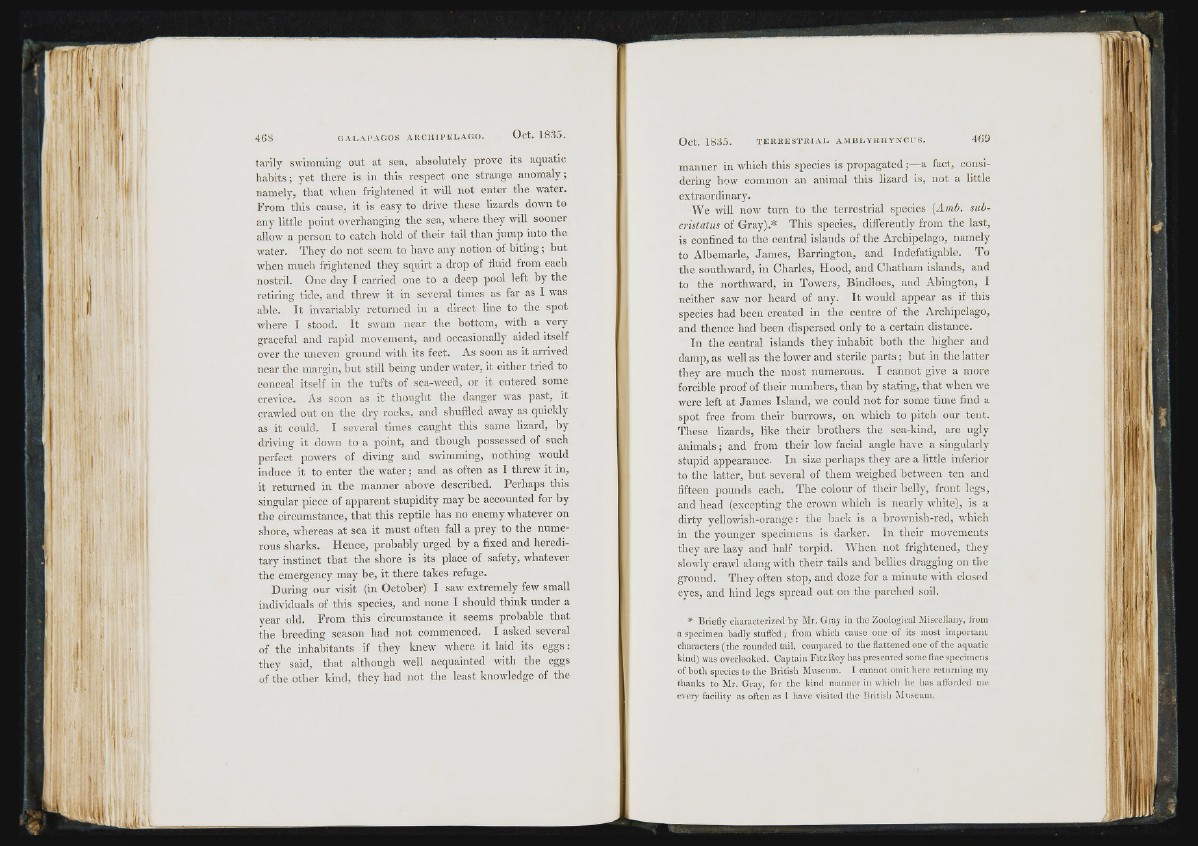
;n
%
i . rii' .
I - I
) ; .
■
tavily swimming out at sea, absolutely prove its aquatic
habits; yet there is in this respect one strange anomaly;
namely, that when frightened it will not enter the water.
From this cause, it is easy to drive these lizards down to
any little point overhanging the sea, where they wiU sooner
allow a person to catch hold of their tail than jump into the
water. They do not seem to have any notion of biting; but
when much frightened they squirt a drop of fluid from each
nostril. One day I carried one to a deep pool left by the
retiring tide, and threw it in several times as far as I was
able. It invariably returned in a direct line to the spot
where I stood. It swam near the bottom, with a very
graceful and rapid movement, and occasionally aided itself
over the uneven ground with its feet. As soon as it arrived
near the margin, Irut still being under water, it either tried to
conceal itself in the tufts of sea-weed, or it entered some
crevice. As soon as it thought the danger was past, it
crawled out on the dry rocks, and shuffled away as quickly
as it could. I several times caught this same lizard, by
driving it down to a point, and though possessed of such
perfect powers of diving and swimming, nothing would
induce it to enter the water; and as often as I threw it in,
it returned in the manner above described. Perhaps this
singular piece of apparent stupidity may be accounted for by
tlie circumstance, that this reptile has no enemy whatever on
shore, whereas at sea it must often fall a prey to the numerous
sharks. Hence, probably urged by a fixed and hereditary
instinct that the shore is its place of safety, whatever
the emergency may be, it there takes refuge.
During our visit (in October) I saw extremely few small
individuals of this species, and none I should think under a
year old. From this circumstance it seems probable that
the breeding season had not commenced. I asked several
of the inhabitants if they knew where it laid its eg g s:
they said, that although well acquainted with the eggs
of the other kind, they had not the least knowledge of the
manner in which this species is propagated ;—a lact, considering
how common an animal this lizard is, not a little
extraordinary.
We will now turn to the terrestrial species {Amh. sub-
aistatus of Gray).* This species, differently from the last,
is confined to the central islands of the Archipelagi), namely
to Albemarle, James, Barrington, and Indefatigable. To
the southward, in Charles, Hood, and Chatham islands, and
to the northward, in Towers, Bindloes, and Abington, I
neither saw nor heard of any. It would appear as if this
species had been created in the centre of the Archipelago,
and thence had been dispersed only to a certain distance.
In the central islands they inhabit both the higher and
damp, as well as the lower and sterile parts ; but in the latter
they are much the most numerous. I cannot give a more
forcible proof of their numbers, than by stating, that when we
were left at James Island, we could not for some time find a
spot free from their burrows, on which to pitch our tent.
These lizards, like their brothers the sea-kind, are ugly
animals ; and from their low facial angle have a singularly
stujrid appearance. In size perhaps they are a little inferior
to the latter, but several of them weighed between ten and
fifteen pounds each. The colour of their belly, front legs,
and head (excepting the crown which is nearly white), is a
dirty yellowish-orange: the back is a brownish-red, which
in the younger specimens is darker. In their movements
they are lazy and half torpid. IVhen not frightened, they
slowly crawl along with their tails and bellies dragging on the
ground. They often stop, aud doze for a minute with closed
eyes, and hind legs spread out on the parched soil.
* B riefly d ia r a c te r iz e d b y M r. G ra y in th e Z o o lo g ic a l llis c e lla n y , from
a sp e c im en b a d ly s tu fled ; from w h ich c a u se o n e o f its m o st im p o r ta n t
c h a ra c te rs ( th e ro u n d e d ta il, c om p a re d to th e f la tte n e d o n e o f th e a q u a tic
k in d ) was o v e rlo o k e d . C a p ta in F itzR o y h a s p re s e n te d som e fine s p e c im en s
o f b o th sp ecies to th e B r itish M u s eum . 1 c a n n o t om it h e re r e tu r ih iig iny
th a n k s to M r. G ra y , fo r tlic k in d m a n n e r in wh ich h e h a s a ffb rilcd m e
e v e ry fac ility a s o f te n as 1 h a v e v isited th e B r itish M u s e um .
J